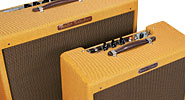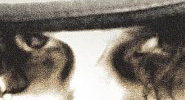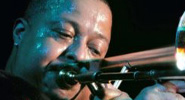
Fender “tweed” guitar amplifiers – the Twin, Deluxe, Bassman, Champ, etc., from the 1950s – are the most sought after amps in the annals of guitardom.
Whether it is Leo’s legendary circuit design, their tweed covering, top-mounted controls, or just killer tone, the “tweed” amp is a true industry standard that has been copied, reissued, and modified by major manufactures (i.e. Fender, Peavey, Carvin.) and boutique builders alike. And today, the values of vintage Fender tweed amps simply put them out of the reach of many players.
Fender’s new reissue ’57 Twin Amp and ’57 Deluxe are built just like they were when Leo was at the helm – with hand-wired/point-to-point circuits on eyelet boards, finger-jointed pine cabinets, lacquered tweed covering, and Alnico-magnet speakers. The ’57 Deluxe has two channels (one Mic, one Instrument) each with two 1/4” jacks and individual Volume controls, as well as a master Tone control and power/standby switches. The Deluxe’s late-’50s 5E3 circuit uses a matched pair of Groove Tube 6V6 power tubes producing 12 watts, a 5Y3 rectifier tube, two high-gain 12AX7 preamp tubes, and a original-spec Jensen P-12Q 12” Alnico speaker. The ’57 Twin also has two channels, one bright and one normal each with two 1/4” jacks and individual Volume controls, as well as passive master Bass and Treble tone controls, a Presence control, and power/standby switches. Valve and speaker layout in the Twin includes a pair of 5U4 rectifier tubes, a matched pair of Groove Tubes 6L6GEs producing 40 watts, four 12AX7 preamp tubes, and two Ted Weber-designed Fender 12” Alnico speakers.

With a Fender Custom Shop Robert Cray Stratocaster and a humbucker-loaded Guild Bluesbird, the ’57 Deluxe offers up a bright, full tone with a very generous serving of musical overtones. The simple, straightforward single Volume and Tone layout allow both guitars’ personalities to shine, with chiming bell tone from the Strat and a lush, fat, articulate humbucker sound from the Bluesbird. This is one of those amps where a reverb circuit isn’t really missed; the thick, saturated sound of the amp needs no help, as its lively, midrange response and clear top-end are very well-balanced. The amp started to break up nicely about halfway on the Volume control, and rolled into a smooth, crunchy overdrive as it heads to full volume. The amp responds well to pick attack and changes in the guitar’s volume controls, making it easy to clean up the sound right at the guitar.
The Deluxe’s combination of light weight (it goes about 25 pounds) and big sound make it an ideal choice for studio work or small-to-medium gigs.

Plugged into the Bright channel of the Twin, the Cray produced a shimmering classic Fender-6L6 clean tone with thick, round bottom and crisp highs. It took very little tweaking to find the sweet spots using the amp’s Bass, Treble and Presence knobs. The well-voiced passive tone controls, along with Presence and the Normal/Bright inputs, make it easy to dial in great, natural sounds, whether you play single-coils or humbuckers.
The ’57 Twin is a real powerhouse, with a loud, full clean sound and a thick, harmonically rich overdrive sound, especially with a high-quality overdrive pedal in front of it.
Fender ’57 Twin Amp/’57 Deluxe
Price: Deluxe $2,569.99 (retail) Twin $2,999.99 (retail)
Contact: Fender Musical Instruments Corporation, 8860 E. Chaparral Road, Suite 100, Scottdale, AZ 85250; phone (480) 596-9690; www.fender.com.






 Korg’s Pitchblack Pro rackmount tuner uses “3D”-style tuning meters with color LEDs, and its treated acrylic face allows a multi-dimensional view of the display from any distance or angle. Its meter has a regular meter mode, strobe mode, and half-strobe mode. It also has a Cable Checker function to detect whether any cable with 1/4″ connectors is broken or shorted. Its buffered output minimizes noise in the signal, and it has a Mute function for silent tuning. The Pitchhawk is a clip-on tuner for guitar, bass, and ukulele with a range of A0 to C8 and a full complement of functionality.
Korg’s Pitchblack Pro rackmount tuner uses “3D”-style tuning meters with color LEDs, and its treated acrylic face allows a multi-dimensional view of the display from any distance or angle. Its meter has a regular meter mode, strobe mode, and half-strobe mode. It also has a Cable Checker function to detect whether any cable with 1/4″ connectors is broken or shorted. Its buffered output minimizes noise in the signal, and it has a Mute function for silent tuning. The Pitchhawk is a clip-on tuner for guitar, bass, and ukulele with a range of A0 to C8 and a full complement of functionality.  Fully chromatic, it includes special markings to indicate pure major third and minor third intervals. The Calibration function accommodates a variety of concert pitches. It uses a CR2032-type lithium battery. Go to
Fully chromatic, it includes special markings to indicate pure major third and minor third intervals. The Calibration function accommodates a variety of concert pitches. It uses a CR2032-type lithium battery. Go to  Trem King Vibrato’s TKS model is now available in a left-hand version. Designed for left-handed solidbody guitars, it has the same features as the right-hand TKS, and offers smooth action with tuning stability the company claims rivals a hardtail. Its tone block spring prevents breakage during upbends and it uses GraphTech Fossillite saddle pins. TKS vibratos are available in several finishes for several styles of solidbody guitars. See more at www.tremking.com.
Trem King Vibrato’s TKS model is now available in a left-hand version. Designed for left-handed solidbody guitars, it has the same features as the right-hand TKS, and offers smooth action with tuning stability the company claims rivals a hardtail. Its tone block spring prevents breakage during upbends and it uses GraphTech Fossillite saddle pins. TKS vibratos are available in several finishes for several styles of solidbody guitars. See more at www.tremking.com. Andrews Amplification’s Spectraverb 40 and Spectraverb 20 amps are U.S.-made and hand-wired on heavy-duty turret boards. Based on Fender’s AB763 circuit, it uses U.S.-made transformers, tube reverb with limiter control, external bias test points and adjustments, two 12AX7, two 12AT7 one GZ34 and two 6V6 (Spectraverb 20) or two 6L6GC (Spectraverb 40) tubes. Options include a series effects loop with true bypass, and a half-power switch. See more at
Andrews Amplification’s Spectraverb 40 and Spectraverb 20 amps are U.S.-made and hand-wired on heavy-duty turret boards. Based on Fender’s AB763 circuit, it uses U.S.-made transformers, tube reverb with limiter control, external bias test points and adjustments, two 12AX7, two 12AT7 one GZ34 and two 6V6 (Spectraverb 20) or two 6L6GC (Spectraverb 40) tubes. Options include a series effects loop with true bypass, and a half-power switch. See more at  Godlyke’s TWA GD-02 Great Divide Analog Synth Octaver combines analog octave division with proprietary synth technology in a pedal that offers five independent voices that can be blended for an array of sounds. It uses TWA’s proprietary S3 Shortest Send Switching – a form of relay-based true-bypass that automatically reverts to bypass if power is lost. Other features include -1 Octave Voice with Level Fader & LPF controls, +1 Octave Voice with Level Fader & LPF controls, +1 Octave Envelope Mode, SUB voice with Level Fader, four waveforms for SYN voice, TRS Effects Loop, and 12 internal controls to adjust voice parameters. For more, visit www.godlyke.com.
Godlyke’s TWA GD-02 Great Divide Analog Synth Octaver combines analog octave division with proprietary synth technology in a pedal that offers five independent voices that can be blended for an array of sounds. It uses TWA’s proprietary S3 Shortest Send Switching – a form of relay-based true-bypass that automatically reverts to bypass if power is lost. Other features include -1 Octave Voice with Level Fader & LPF controls, +1 Octave Voice with Level Fader & LPF controls, +1 Octave Envelope Mode, SUB voice with Level Fader, four waveforms for SYN voice, TRS Effects Loop, and 12 internal controls to adjust voice parameters. For more, visit www.godlyke.com. Option Knob’s VKnob offers improved control for electric-guitar players. An alternative to the traditional Volume knob, it enables a player to execute fine-tuned volume control and lightning-fast volume swells. Its “arm” design extends the guitar’s Volume control closer to the strumming area, making it quicker and easier to adjust on the fly, rapidly move the arm up and down to create tremolo effects at any tempo, or couple your pinky finger with the notch on the tip of the arm to fine-tune the volume level on every individual note you pick. Visit VKnob.com.
Option Knob’s VKnob offers improved control for electric-guitar players. An alternative to the traditional Volume knob, it enables a player to execute fine-tuned volume control and lightning-fast volume swells. Its “arm” design extends the guitar’s Volume control closer to the strumming area, making it quicker and easier to adjust on the fly, rapidly move the arm up and down to create tremolo effects at any tempo, or couple your pinky finger with the notch on the tip of the arm to fine-tune the volume level on every individual note you pick. Visit VKnob.com. SynapticGroove’s Snapperhead OD/Distortion is an op-amp based pedal hand-made in the U.S. using components with 1 percent tolerance. It uses 200mA of 9-volt power and has controls for Level and Drive, and an LED indicator for battery strength. Learn more at www.synapticgroove.com.
SynapticGroove’s Snapperhead OD/Distortion is an op-amp based pedal hand-made in the U.S. using components with 1 percent tolerance. It uses 200mA of 9-volt power and has controls for Level and Drive, and an LED indicator for battery strength. Learn more at www.synapticgroove.com. The Epiphone G-400 PRO and the vintage-styled Ltd. Ed. 1966 G-400 PRO models carry classic features of the original versions, including a mahogany body and neck, twin cutaways, and Wilkinson machine heads. The new uses Alnico Classic PRO pickups with push/pull coil-tapping and made with the same wire and magnets as the originals. Visit
The Epiphone G-400 PRO and the vintage-styled Ltd. Ed. 1966 G-400 PRO models carry classic features of the original versions, including a mahogany body and neck, twin cutaways, and Wilkinson machine heads. The new uses Alnico Classic PRO pickups with push/pull coil-tapping and made with the same wire and magnets as the originals. Visit